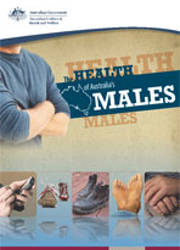Summary
There is increasing awareness that males and females have distinct health needs and concerns related to their biology and roles in society. This is illustrated by different rates of injury, illness and mortality; different attitudes towards health and risks; and the way each group uses, or does not use, health services. In this context, in May 2010 the Australian Government launched the National Male Health Policy, which provides a framework for improving the health of Australia’s males (DoHA 2010a). This report is the first in a series funded under the Policy.
Drawing on a range of data sources, this report presents a snapshot of the health and wellbeing of Australia’s males. It is not intended to be exhaustive, but to provide a summary for policymakers, researchers and others interested in male health issues, and set the scene for future reporting and research.
Australia’s males at a glance
In June 2010, there were 11.1 million males living in Australia – just under half of the total population (ABS 2010a). The median age was 36 years; 20% of males were aged under 15 years and 12% were aged 65 years and over. The male population is continuing to age, associated with increasing life expectancy.
Some males make healthy lifestyle choices and have positive health outcomes…
- around two-thirds of males participate in sport or physical activity (2009–10)
- nearly 40% of males discuss healthy lifestyle issues with a health professional (2007–08)
- 20% of males rate their health as excellent (2007–08)
- survival rates for prostate and testicular cancer have improved overall (1998–2004).
But many males are still at risk of poor health…
- 5% of adult males consume sufficient fruit and vegetables (2007–08)
- around two-thirds of adult males (18 years and over) and one-quarter of boys (5–17 years) are overweight or obese (2007–08)
- half of all males report being a victim of violence at least once in their lifetime (2005).
And many males are already experiencing poor health…
- 4% of males rate their health as poor (2007–08)
- nearly half have ever had a mental health condition (2007), nearly one-quarter have a disability (2009) and nearly one-third have a chronic health condition (2007–08).
With under-use of some health services…and over-representation in others
- males make up a smaller proportion of GP encounters (2009–10), hospitalisations (2008–09) and some mental health services (2008–09) compared with females
- males make up a greater proportion of emergency department presentations (2008–09) and some other mental health services (2007–08) compared with females
- 16% of males do not use any Medicare services in a year (2008–09).



